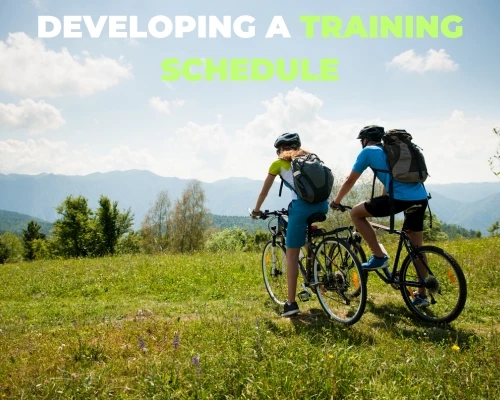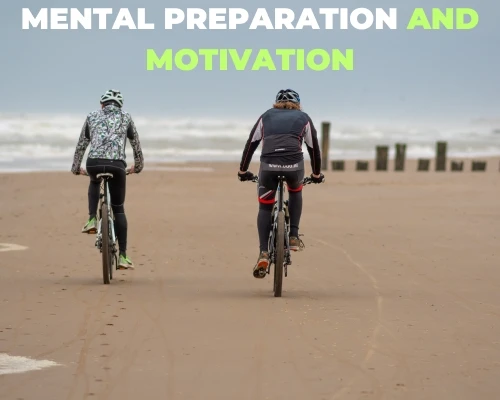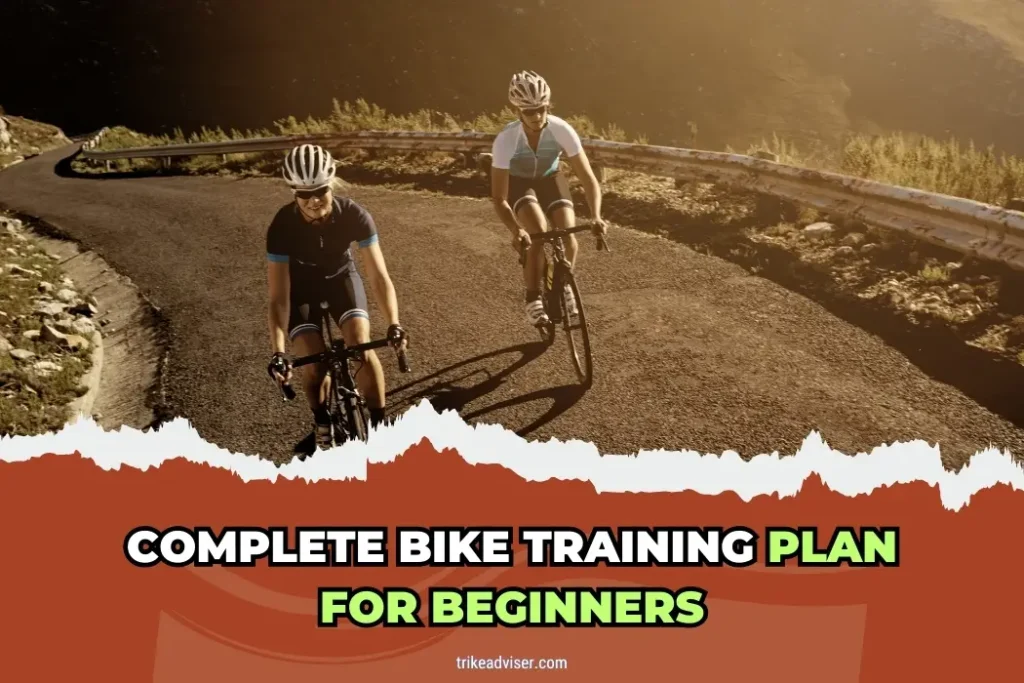Starting your cycling journey feels daunting, right? Many beginners worry about not getting it right from the start. You’re not alone. Feeling overwhelmed by where to begin is common.
Here’s how to simplify it:
Will you ride primarily on roads or trails? This shapes your training plan’s focus. Is your main goal fitness or are you leaning towards competitive racing? Your answer tweaks the intensity. Think you need top-tier equipment to start? You don’t.
Understanding these points helps tailor your beginner’s training plan. Avoid common pitfalls and build confidence step by step. No need to rush; progress at your own pace. Let’s gear up to pedal smoothly into this new adventure!
Complete Bike Training Plan For Beginners
Duration of the Training Plan
A 10-week training plan suits beginners perfectly. It builds aerobic fitness and endurance without rushing. Start slow, build strong foundations. No need to rush into intensity.
Weekly Commitment
Expect to spend about 6.5 to 8 hours weekly. This includes both on-bike and off-bike sessions. Off-bike exercises are crucial. They prevent injuries and strengthen your body comprehensively.
Training Structure
Split your training into two five-week blocks. The first block focuses on low-intensity workouts. These help you build stamina without overwhelming your body. The second block introduces higher intensity. This boosts endurance and overall fitness. Gradual escalation is the key.
Training Targets
By the end of your 10 weeks, aim for a big goal. Ride confidently at a consistent pace for around three hours. This shows significant progress in your endurance and bike handling.
Cross-Training
Mix it up with running, swimming, or walking. These activities on cross-training days prevent monotony. They also maintain your overall fitness. Balance is crucial for a beginner.
Bike Handling Skills
Improve your bike handling skills, pedaling cadence, and gear control. These enhancements boost your confidence and control on the bike. Mastering these skills makes your rides smoother and safer.
Training Zones
Learn to use training zones. They’re based on heart rate or power output. Training zones help tailor your workouts more effectively. They ensure you’re always working at the right intensity.
Consistency
Consistency is your best friend in training. Aim to ride most days of the week. Regular rides lead to noticeable improvements in your cycling performance. Stick with it, and see the results.
Setting Up Your Bike

Choosing the Right Bike for Your Goals
Road bike or mountain bike? Think about what you’re really after. Speed or rugged terrain handling? Set your budget early. More cash can mean more features, but basics do the job well. Research different bikes. Understand what each type offers you.
Basic Bike Setup: Adjusting Your Bike to Fit
- Frame Size: Just right means about an inch of space from you to the top tube.
- Saddle Height: Adjust so your knee is slightly bent at the pedal’s lowest point.
- Tip: Sit on the saddle, heel on the pedal, and spin backwards.
- Saddle Position: Slide it back or forth. Your knee should line up over the pedal spindle.
- Check: When the foot is at the bottom, your knee should be right above it.
- Handlebars: Find a comfortable spot. Not too high, not too low.
- Balance: Adjust for comfort and a bit of aerodynamics.
- Stem Length: Right length keeps you comfy. Too long? You’re stretched. Too short? You’re cramped.
- Test: Change lengths, find what feels best.
- Pedals and Cleats: Position for a natural foot angle. Adjust the cleat for minor tweaks.
- Comfort Key: Make sure your knees feel good.
Testing and Tweaking
Got everything set? Take a spin. Notice anything off? Adjust and try again. Still not right? A professional fit might be worth it. They tailor everything to your body’s specifics.
Developing a Training Schedule

Crafting a training schedule is key for cycling success. It means knowing the season’s demands and balancing training loads effectively.
Understanding the Cycling Season: Timing Your Training
The cycling year is divided into distinct phases, each with a purpose:
- Base Phase: Build a solid aerobic base here. Focus on endurance. This phase spans several weeks or even months during the off-season.
- Key Strategy: Long, steady rides are your best friend.
- Build Phase: Now, ramp up intensity and volume. You’re pushing to improve both fitness and power.
- Workout Example: Increase the length and intensity of your efforts gradually.
- Peak Phase: The final prep for your big event. Sharpen fitness, refine race skills, and start to taper.
- Final Touches: Practice race-specific scenarios and begin reducing training volume to peak at the right time.
- Transition Phase: Time to rest and recover post-peak. Engage in cross-training and mental rest to rejuvenate.
- Activities: Light swimming, yoga, or casual rides can help maintain fitness without overloading the body.
Balancing Frequency, Intensity, and Time (FIT Principle)
Mastering the FIT principle can transform your training:
- Frequency: How often are you cycling? Start with three to four sessions per week. Sprinkle in cross-training to enhance your fitness without burnout.
- Consistency is Key: Regular sessions build fitness more effectively than sporadic efforts.
- Intensity: This is about how hard you push during training. Most of your work should be in lower intensity zones to build endurance.
- Guided Efforts: Use heart rate or power zones to keep your training on target.
- Time: How long are your sessions? Gradually extend your ride durations. Include a long ride weekly to boost endurance.
- Incremental Increases: Start with manageable times, then extend as your fitness allows.
Sample Beginner’s Cycling Plan
- Weeks 1-4 (Base Phase):
- Monday: Rest
- Tuesday: 60 minutes, including 2×10 minutes in Zone 3
- Wednesday: 30-minute group ride or time trial
- Thursday: 60 minutes with 2×12-minute threshold efforts
- Friday: Rest or easy 30-minute spin
- Weekend: 90-minute endurance ride
- Weeks 5-8 (Build Phase):
- Monday: Rest
- Tuesday: 90 minutes with 3×10-minute Zone 3 efforts
- Wednesday: 30-minute group ride or time trial
- Thursday: 90 minutes with 3×12-minute threshold ramps
- Friday: Rest or easy 30-minute ride
- Weekend: 2-hour endurance ride
- Weeks 9-12 (Peak Phase):
- Monday: Rest
- Tuesday: 120 minutes with 4×10-minute Zone 3 efforts
- Wednesday: 30-minute group ride or time trial
- Thursday: 120 minutes with 4×12-minute threshold efforts
- Friday: Rest or easy 30-minute ride
- Weekend: 3-hour endurance ride
Mental Preparation and Motivation

Goal Setting: Realistic and Achievable Objectives
Setting goals sounds easy, right? It’s not just about dreaming big. It’s about being smart.
- Define and Conquer: Pick goals within reach but challenging. Like riding further each week.
- Step by Step: Big goals? Break them down. Celebrate small victories on your way to big ones.
- Visual Progress: Keep a log. Seeing your achievements in black and white is a powerful motivator.
Staying Motivated: Tips for Keeping Your Training on Track
Ever felt like skipping a ride? Here’s how to keep the pedals moving.
- Inspirational Goals: Set goals that get you excited. Perhaps a picturesque route or a new distance record.
- Follow the Plan: A structured plan keeps you focused. Check your progress, and adjust as needed.
- Know Your Zones: Training smart means knowing your heart rate zones. It helps, seriously.
- Variety Is Key: Mix it up. Endurance rides today, sprints tomorrow. Keeps boredom at bay.
- Rest to Ride: Recovery days are sacred. They build strength and prevent burnout.
- Talk It Up: Tell yourself you can do it. Positive talk during tough rides works wonders.
- Break It Down: Long ride ahead? Tackle it piece by piece. Focus on reaching the next milestone.
- Redirect Thoughts: Overwhelmed? Think about your posture or what you’ll eat later.
Troubleshooting Common Cycling Challenges
Overcoming Plateaus in Training
Stuck at the same level? It’s common. Let’s break through that plateau.
- Reset Goals: Reevaluate what you’re aiming for. Adjust if needed, keep them challenging yet achievable.
- Mix It Up: Change your routine. New workouts can reinvigorate your training.
- Plan by Periods: Organize your year into training blocks. Each with unique focus points.
- Assess and Adapt: Use tests like 30-minute time trials to gauge progress. Tweak plans as you go.
- Embrace Rest: Never underestimate recovery. It’s essential to avoid overtraining.
Dealing with Common Injuries and How to Prevent Them
Pain shouldn’t be a regular training partner. Here’s how to stay injury-free.
- Warm-Up and Cool Down: Essential rituals. Start with warm-ups, end with cool-downs to protect your body.
- Fit Your Bike Right: Ensure your bike fits perfectly. Adjust saddle height and position, handlebars, and stem length.
- Strengthen and Stretch: Incorporate stretching and strength training. They help prevent imbalances and enhance flexibility.
- Schedule Down Time: Plan rest days. Crucial for repair and recovery.
- Listen and React: Pay attention to body signals. Address discomfort early to prevent worse issues.
As an Amazon Associate, I earn from qualifying purchases, at no additional cost to you. Read Our Affiliate Disclosure.

